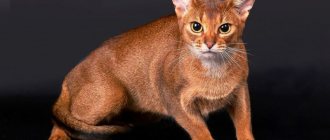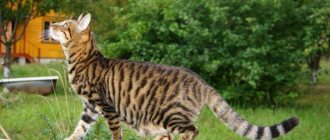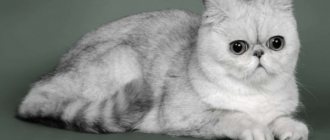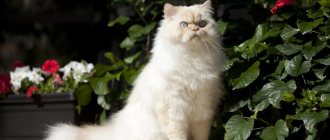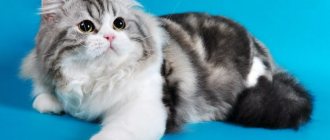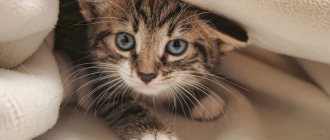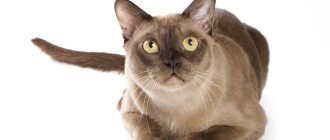- Pets
- >>
- Cat breeds
* Here is a photo of a typical representative of the Chausie cat breed . You can send us photos of your animals by email [email protected] and we will post them on the website. Don't forget to send your pet's name.
Other breed names:
Chauzie
Video
* We invite you to watch a video about the Chausie . In fact, in front of you is a playlist in which you can select and watch any of 20 videos about a given cat breed by simply clicking on the button in the upper right corner of the window. In addition, the material contains quite a lot of photos. By looking at them you can find out what Chausie looks like.
Rate the material!
[Total votes: 0 Average: 0]
Today there is a wide variety of cat breeds. Chausie cats as the most exclusive and unusual. This breed was developed by crossing a domesticated Abyssinian cat and a jungle cat. As a result of crossing a rare breed with a wild cat, the result was a cat of incredible beauty and grace. Representatives of this breed are among the five most expensive cats in the world. They are believed to have an incredibly graceful, attractive, aristocratic appearance and a combination of incredible genes.
Health
Hybrid breeds do not tolerate anesthesia or many medications well and are sometimes sensitive to vaccines. They have specific reactions and symptoms that are different from house cats
Therefore, it is important to inform your veterinarian about the origin of your pet.
A few breeders keep information about genetic diseases of the Chausie secret. It is known that they inherited congenital polycystic kidney disease from the Abyssinians. At one year of age, it is necessary to undergo an ultrasound to exclude the presence of cysts.
Chausie cats have been diagnosed with the following diseases:
- Chediak-Higashi syndrome, leads to decreased immunity and death of kittens;
- hemophilia - a blood clotting disorder, cats are more often affected;
- retinal atrophy, glaucoma, cataracts lead to blindness;
- primary hyperoxaluria – accumulation of oxalic acid salts, kittens die before they are one year old;
- Gluten intolerance - bloating, rumbling, vomiting, constipation or diarrhea, skin manifestations from rashes to baldness. Gluten is excluded from the diet (wheat, rye, barley).
The list is probably not complete; choosing a nursery should be approached with double responsibility. To participate in the breeding program, it is better to purchase a kitten in co-ownership with an experienced breeder. Abyssinians and their mestizos are often sold under the guise of F3 and beyond. The price of kittens of the first two generations starts from $2000.
History of the origin of chausie
Ancient Egypt is considered the historical homeland of this exotic beauty. In the vast expanses of the Nile River valley lived the ancient ancestors of the Chausi - jungle cats. Cats led a wild lifestyle and coexisted quite peacefully with the people of that time. The ancient Egyptians did not perceive cats as representatives of a unique and very rare breed. The profile of this cat became the prototype of the ancient goddess Bastet, who was the patroness of all cats and the family hearth.
Discovered ancient frescoes that were found by researchers indicate that cats quite densely populated Ancient Egypt. They occupied an honorable place in the life of the ancient Egyptians and were an integral part of the life of that time.
Interesting fact: According to some sources, cats were excellent hunters. They often settled in close proximity to people, living with them under the same roof, saving them from rodents.
The period of existence and reign of powerful pharaohs is a thing of the past, but people still coexisted with these amazing animals.
Exotic appearance, beauty and grace were not particularly interesting to scientists and researchers of that time. Interest in these cats first arose only in the second half of the 20th century. This happened thanks to the stories of American tourists who visited Egypt and saw the cat. The description of the animal compiled by tourists interested American breeders.
In 1960, cats were first brought to America. Breeders began a long and complex activity of crossing jungle cats with other cats. Scientists sought to preserve and consolidate the existing characteristics and appearance of a foreigner, and at the same time instill in them the softness and docileness of a domestic cat.
As a result of numerous attempts, it was found that the Abyssinians are the most suitable species for crossing. The name of the resulting breed was borrowed from its ancient ancestors. The scientific name of the jungle cat genus is Felis chaus. The breeders left the second part, changing it slightly.
More than thirty years passed from the moment the breed was created and its breeding until they were officially recognized. It was only in 1995 that they were given provisional status by TICA. In the same year, a standard was drawn up and adopted. The new breed was registered only in 2003.
Chausie - description of the breed
These cats cannot be confused with any others. Representatives of this breed are most common in Asia, the Middle East and the States. In some countries they are called "house". You can find them under the name “swamp cat”.
The Chausie cat is a fairly large animal. The height at the withers is 40-50 centimeters, the body weight of an adult is 10-15 kilograms. Animals have well-developed muscles. There is a subtle sexual dimorphism. Female individuals are more graceful and small.
Distinctive features of the breed:
- Head and skull. Cats have a wedge-shaped head. Its size seems small relative to its body dimensions. The head is quite elegant, there is no angularity or sharp lines. The frontal part is quite wide and flat. High on the head, almost on the top of the head, there are large, widely spaced ears, very wide at the base. They have a triangular shape. The ears are pointed at the top and have small tassels at the tips. Animals with pussies on their ears are very highly valued, but if they are not there, this is not a deviation from the standard or a defect.
- Muzzle. The muzzle is neat, with smooth features. The nose and chin are fairly straight. The transition line from the forehead to the nose area is quite sharp and clearly visible. The line of the bridge of the nose in females is narrower and less noticeable than in males.
- Jaws. Animals have fairly developed, powerful and strong jaws. They form a scissor or level bite.
- Torso. The animals have a massive and very long neck. Dense, strong physique with well-developed muscles. They have a fairly wide chest and narrow shoulder line. The bottom line is tightened and gives the impression of slimness and elegance. The back is straight and level.
- Tail. The Chausie has a straight, long and very graceful tail. Its length is almost equal to the length of the animal’s body. It is mobile, without creases.
- Limbs. Cats have very long, graceful limbs. With their help, animals can easily climb to the highest surface. The toes do not fit tightly together.
Popular Chausie colors
One of the distinctive features of this breed is its coat and color. The coat is short with very dense and tightly adjacent fibers. Because of this feature, it seems that the cats are plush. The fur shines and shimmers in the sun. Representatives of this breed have a well-developed undercoat. The guard hairs are unevenly colored in two or more areas of the body.
The standard specifies three main color varieties for cats of this breed:
- Black. Cats are painted almost entirely this color. There are practically no marks on the body;
- Ticked black tabby. The hair is dyed in several colors. The undercoat is colored reddish-golden. On the inner surface of the limbs and tail. The chin area and the rims around the eyes are painted a lighter color;
- Silver-black. There are two or three stripes on the guard hair. Most often they are painted silver or black. Brightly colored point tabbies are considered a departure from the standard.
In addition to the three colors listed above, there are other color options, but they are less in demand. Individuals painted in other colors are not allowed for mating.
Sometimes cats can be brindle or leopard in color. This is not considered a defect or non-compliance with the standard.
How to buy a Housie kitten
Becoming the owner of a Hausie kitten is quite difficult. There are several problems along this path:
- Officially registered nurseries are located mostly in the USA and a little in France. There is unconfirmed information about a Russian nursery breeding hybrids, including the Hausie.
- Due to the difficulty of breeding, the cost of kittens is high. First generation F1 hybrids can cost from five hundred thousand rubles to one million. The cost of an F5 class kitten is about one hundred thousand, this is the lowest price for a Hausie on the official market.
Nurseries prefer to give away kittens at three months of age
When choosing a kitten when purchasing, pay attention to the following:
- Appearance that meets breed standards: color, muzzle shape, location of black spots. In a Hausie of any color, the tip of the tail and the edges of the ears are always painted black, and a “necklace” of black spots can be seen on the neck; babies belonging to the F1 subgroup, in addition, have black spots on the back of their ears.
- External signs of good health: no discharge from the eyes and ears, clean coat without bald spots or scratches, sharp claws without damage.
- Kitten behavior: he should be active and friendly. Manifestation of passivity, drowsiness, and aggressiveness is undesirable, although a long journey can negatively affect the baby’s condition.
- It is advisable to see the parents of the little Hausi. If this is not possible, then familiarize yourself with the photographs and documents on them.
- When communicating with the nursery employee accompanying the baby, try to get more information about the nursery and the peculiarities of keeping a Hausie. The level of competence of the breeder's representative will help determine the cattery category.
- When purchasing a kitten, the following documents must be presented:
- a purchase and sale agreement, which includes an indication of castration or sterilization and the opportunity to take part in exhibitions (these points affect the cost of the baby);
- passport with his pedigree, name and date of birth;
- veterinary documents indicating the date of vaccinations.
Character and habits of the Chausie
It may seem that direct kinship with wild cats will add aggression and uncontrollability. However, cats of this breed are very lively, sociable and cheerful. Pets always reciprocate the caresses and hugs of their owners. However, chauzes are distinguished by their waywardness and independence. Cats are very attached to their owner. They very often demonstrate their love and devotion to their owner.
Those who want to get this particular cat are advised to take into account the characteristics of his character and respect his desire for independence and independence. Those who want to get a real, but domestic Chausie, are recommended to choose a kitten in the fourth generation. They are the ones who have a more flexible, soft and homely character.
Pets tend to stock up in the most secluded corners. Often during cleaning, owners discover such hiding places in various parts of their home. This doesn’t have to be food, it can be any items the cats like. This habit explains the desire to take care of themselves, which is characteristic of wild cats.
Interesting fact: Many breeders of this breed note that cats have real telepathic abilities. They seem to be able to predict the actions and wishes of the owner.
Chausies are very smart and quick-witted animals. They are endowed with amazing intelligence and developed intelligence.
Another feature of the breed is its incredible activity. It is difficult to catch them sitting in one position. It is best if cats are kept with enough space to jump and climb as much as nature requires. If pets are left alone for a long time, it is best to provide them with a sufficient number of toys.
Surprisingly, unlike most cats, Chausies love water treatments and enjoy taking a bath. Representatives of this breed do not like to be left alone. They get along easily and quickly find a common language with other pets. Children can also make friends with animals quite quickly.
Interesting facts about chausie
The Chausie cat breed is very unusual and is of interest to many animal lovers.
Let's find out the most interesting facts about these cats:
- Many males are born already sterile and unable to give birth to offspring;
- Unlike most cats, Chausies love to take water treatments;
- Representatives of this breed can be easily walked on a leash. They calmly accept this method quite calmly;
- Despite the fact that the Chausie easily and quickly finds a common language with other pets, they should not be kept together with rodents and birds. The hunting instinct will sooner or later take over;
- One of the favorite activities of Chausie cats is steeplechase running and rock climbing;
- Some representatives of this breed have tufts on the ears and the tip of the tail. They must be small in size and always only black;
- Cats of this breed have a very specific appearance. Their peculiarity is their unusual color scheme. They are not characterized by ordinary, standard colors. The usual gray, red and white are completely absent from the breed standard;
- The second name for chausie is small puma. Outwardly, cats really resemble these amazing animals;
- The peculiarity of cats is that they almost never release their claws during play, so it is almost impossible to get injured or scratched;
- The undemanding nature of their living conditions, which they inherited from their wild ancestors, makes them a very tempting and sought-after breed;
- It is believed that chausies have psychic abilities and can guess the wishes of their owner.
Upbringing
Chausies love to play and are easy to train
They begin raising a kitten immediately after it appears in the apartment. Get him used to the scratching post and litter box. Whenever your pet tries to damage furniture or interior items, explain that this cannot be done, using strict intonation. Chausies have a developed intellect and are able to understand what their owner wants from them. Accustom your pet to a leash from an early age.
Video: Chausie performs tricks
Pros and cons of chausie
Any breed has certain advantages and disadvantages. Before you get an animal, you should thoroughly study all its features.
Advantages of the Chausie breed:
- Representatives of this breed are intended for true connoisseurs of animal beauty;
- Gets along and quickly finds a common language with other pets;
- Loves children and does not show aggression towards them;
- During the game it will never injure or scratch the owner;
- Features an incredible, exotic and unforgettable appearance;
- Has good health and strong immunity;
- A very sociable, cheerful and mischievous cat. She loves outdoor games and fun;
- Doesn't require much attention.
Disadvantages of the Chausie breed:
- A very expensive breed that not everyone can afford;
- Quite rare. In Russia there are no more than a dozen representatives of this breed;
- Requires a lot of space;
- Cats often become infertile, unable to produce offspring;
- It is necessary to monitor nutrition, as this is one of the animal’s weaknesses. They do not tolerate fatty meats and grains, they only need filtered or boiled water;
- If cats are left alone for a long time, you can end up with damaged furniture and interior items, as well as torn wallpaper and curtains;
- Animals are prone to obesity due to poor diet and lack of physical activity;
- Caring for and maintaining pets is quite expensive.
How much does it cost and how to choose a kitten
Since the Chausie breed is very rare, the price of kittens reaches high values. A small pet will cost from 100 thousand rubles.* There are no specific price ranges, since the breed is difficult to find. Each breeder sets his own price. There were cases when a kitten was bought for 1 million rubles.
It is best to purchase an animal at least 3 months old. The appearance of the baby completely coincides with the adult, so they pay attention to compliance with the established standard. The kitten should not be lethargic. A healthy baby's ears and eyes are clean and his fur is free of bald spots. There should be no wounds on the skin.
At the time of purchase, the breeder is required to present the following documents:
- contract of sale;
- pedigree of the cat;
- veterinary passport showing vaccinations.
Note! When buying an animal, you should study the documents of the place where they are bred. This must be a specialized nursery with permission to breed this breed. Otherwise, the person involved in illegal sales may be arrested.
It is difficult to find purebred Chausies in Russia, so you should go to the USA or France to get kittens. Otherwise, you may run into scammers.
Breeding Chausie
Breeding chausie is a very complex and labor-intensive task. It is best to take the help of specialists. Chausie cats have an excellent set of genes. However, despite this, they very often become infertile. Males are most susceptible to this. Most of them cannot participate in mating after the first offspring. Females retain the ability to reproduce for a longer time.
When crossing Chausie cats, it is very important to choose a suitable partner. Wild or ticked Abyssinians may be suitable options. Only in this case can you get a purebred Chausie kitten.
If the partners liked each other and crossing took place, then after 60-70 days from 2 to 5 kittens will appear. It is recommended to purchase kittens or look for a suitable match for mating in well-known nurseries. This way there is a guarantee that the cat you get will be truly purebred, perhaps even with a pedigree.
Interesting fact: At three months of age, kittens adapt more easily and quickly to new living conditions, are accustomed to the litter box, and have developed a feeding routine.
During pregnancy, cats do not require any special care, with the exception of a more careful diet and the addition of vitamins and minerals.
Kinds
Chausie, the breed description of which is presented above, is divided into several types. They differ in the percentage of Hausa blood and are designated by the letter F (branch).
F1
Ocicat cat - description of the cat breed, red kitten
Chausie F1 is a semi-wild pet that has at least 50% of the blood of a purebred cat. This species can be tamed, but the cat cannot be completely domesticated.
Note! If the pet is not kept or handled correctly, the Housie may attack its owners.
F2
To obtain this species, you must have 25% of the genes of a real cat in your blood. The average weight of representatives is 6-9 kg. They are easier to tame and domesticate. Compared to option 1, Chausie F2 have a more loyal temperament.
F3
The character and size of this cat is closer to the domestic species. Therefore, it is difficult for a non-professional to immediately distinguish an ordinary cat from a house cat. The percentage of wild animal blood must be at least 12.5%.
F4
This variety has 6.25% Chausie blood. Cats are easily domesticated and are considered peaceful and calm. They have small dimensions.
F5
In this case, the result is 3.12% Hausa blood. According to the description of Chausie F5, it is completely similar to F4.
Weight of an adult is from 12 to 15 kg
Chausie care
Chausie is one of the youngest and most expensive breeds in the world. Not everyone today has the opportunity to have such a pet. Firstly, not everyone can afford it. Secondly, the breed has not been sufficiently studied and there is no reliable data regarding the care and maintenance of the animal.
Chausie is a very active and inquisitive cat. She definitely needs to be provided with a sufficient amount of space and daily walks in the fresh air. If you have to walk your pet within the city, and not on your own plot, then you need to purchase a leash.
To organize leisure time and preserve property and interior items, you need to purchase a sufficient number of toys. Caring for animals does not require much time and effort.
Measures for caring for chausie:
- The coat needs to be brushed daily with a soft brush;
- You need to brush your ears and teeth every day;
- From time to time it is necessary to arrange games for the cat in the water;
- It is important to visit your veterinarian for examinations, nail trims, and required vaccinations;
- It is imperative that your cat is dewormed;
- Nutrition must strictly comply with all criteria and standards;
- Periodically, if necessary, give the cat the opportunity to hunt;
- Be sure to purchase a scratching post for your pet.
Maintenance and care
Wild blood enhances natural instincts of self-preservation. To increase the chances of survival and successful hunting, the animal must have perfectly clean, odorless fur, so Chausie is given a lot of time for licking. Do you think that even if a cat is clean, it still needs to be bathed? – Please, at least every day, Chausies love water and will come to your shower if you don’t lock the bathroom doors.
There are several restrictions in terms of feeding. The Chausie's intestines are slightly shorter than those of standard domestic cats, which can lead to indigestion. The small distribution of the breed does not make it possible to make accurate and objective conclusions about what to feed your pet. One thing is known, Chausies are omnivores, however, hard-to-digest foods should be avoided (cereals, flour products, potatoes). In nurseries, animals are kept exclusively on super-premium industrial food, which does not contain grains and is intended for cats with sensitive digestion.
It is recommended to comb the coat weekly with a massage glove. No, not so that the fur coat does not get tangled. By stroking your cat with a glove, you stimulate blood circulation, which has a positive effect on the tone of the body and the appearance of the coat. Eyes and ears are cleaned as needed, but healthy animals with a balanced metabolism need this extremely rarely.
Caring for claws and teeth is also easy. For large Chausies, the scratching post is too frivolous a tool. You can train your pet to sharpen its claws on wood or make a suitable scratching post with your own hands. Teeth need regular examination; Chausie is recommended to be fed industrial food, which “removes the issue” of cleaning. If the cat eats natural food, the diet must include boiled cartilage, tendons and other “long-lasting” products that the pet will use to brush its teeth. It is also recommended to use hygiene sticks and special toothpastes.
Chausie diet
Nutrition is one of the most difficult aspects of keeping and caring for animals. They have a very immodest appetite and a very sensitive digestive tract. When organizing meals, it is worth considering that the digestive tract is not able to digest grains. The problem is that they are included in most ready-made balanced feeds. The basis of the Chausie diet is meat.
Important fact: Of all types of meat, it is recommended to choose exclusively low-fat varieties. Pork chausie is strictly prohibited. As a source of protein, choose raw, fresh, lean meat - beef, rabbit, turkey, quail.
When organizing meals, it is very important to observe the frequency of feeding. Animals under six months of age are fed twice a day. For older cats, it is enough to feed them once a day. It is periodically recommended to give your pets fasting days.
By nature, Chausies are wild cats, born hunters. In their natural habitat, their ancestors led a very active lifestyle, constantly on the move. At home, cats move much less, so they are very prone to obesity.
You can add some grains to your diet - cook porridge from oatmeal or rice. It's best if it's brown rice. Be sure to give animals fermented milk products with a low fat content. No more than 10% of the diet should be carbohydrates. Adding small amounts of vegetables or fruits to the diet is allowed.
You can feed representatives of this breed with prepared food. Holistic is one of these. This is a new generation of food for animals. They are made on the basis of human food: meat, fish, fresh fruits and vegetables. The advantage of this type of food is that it consists only of natural products without preservatives, food additives or fillers.
Another advantage in favor of this food is the optimal ratio of vitamins and minerals, as well as the absence of grains. Be sure to provide your pet with fresh, clean water. It must be boiled or filtered.
Within-breed differences
Depending on the degree of close relationship with felis chaus, there are 4 groups of chausie cats.
Cornish Rex
Korat cat
Nibelung
The higher the percentage of wild blood, the larger and more expensive the kitten:
- F1 is a direct descendant of the domestic cat and the jungle cat. A semi-wild pet, tamed, but not capable of full domestication. It can pose a danger even to the owner if the conditions of detention are violated and handled illiterately. The average weight is 12 kg, some individuals reach 15 kg.
- F2 – the F1 cat is bred to an Abyssinian, which results in ≈25% of the jungle cat genes. Smaller, calmer, but the wild appearance is still noticeable. Average weight 6-9kg.
- F3 – domestic cat and F2, ≈12% wild genes. This kind of chausie is almost no different from ordinary murk. Only a professional would recognize a wild ancestor in her.
- F4, F5 and beyond look like pumped-up Abyssinians with strong bones and powerful chests. This is 90% of all kittens sold to the general public. They are taken out of breeding or used for mating with previous generations.
Buying an F1 or F2 is difficult, especially if you are not a breeder. This is valuable genetic material that is very expensive. It is impossible to find such a kitten based on an advertisement - these are scammers. It is necessary to take into account that in some regions there is a restriction or ban on keeping wild animals and 1st and 2nd generation hybrids.
Diseases and health problems
By nature, cats are endowed with strong immunity and good health. They are not too susceptible to various pathologies. However, it is worth considering that, like all other animals, chausies are susceptible to infection with helminthic infestations. Representatives of this breed have a rather weak digestive system, and therefore they can get sick if they are not fed properly.
Interesting fact: Insufficient physical activity can cause obesity. Therefore, it is very important to follow the regimen and frequency of meals, as well as move enough.
After bathing and water procedures, cats need to be dried in a warm room without drafts, as they are prone to colds. Colds are manifested by discharge from the eyes, sneezing, watery eyes, lethargy, and refusal to eat and drink.
Everyone knows that chausies have an excellent appetite. Once you leave the cats alone with food, he will certainly enjoy plenty. The owner of these cats must understand how important it is to regularly visit the veterinarian and get all the necessary vaccinations.
Be sure to comb out six. Cats tend to lick themselves. If the fur is not combed out, it ends up in the stomach. Indigestion develops. In severe cases, the animal may even die.
Once every one and a half to two years, it is recommended to visit a specialist to remove tartar. If this is not done, there is a risk of developing gingivitis, tooth loss, and inflammatory processes in the oral cavity.

